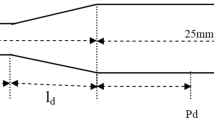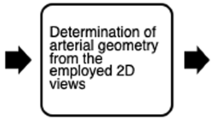Abstract
Enhanced external counterpulsation (EECP) is a noninvasive treatment method for coronary artery atherosclerosis that acts on the vascular endothelial cells. The intracoronary hemodynamic parameters that influence long-term treatment effect are the fundamental factors for the inhibition of intimal hyperplasia, which cannot be measured in real time. In order to optimize the long-term treatment effect of coronary heart disease, it is necessary to establish a method for quantified calculation of intracoronary hemodynamic parameters during counterpulsation to research the long-term hemodynamic mechanism of EECP. A geometric multiscale model coupled by the zero-dimensional (0D) lumped parameter model and the three-dimensional (3D) model of narrow coronary artery was established for the simulation of intracoronary hemodynamic environment. The 3D model was used to calculate the hemodynamic parameters such as wall shear stress (WSS) and oscillatory shear index (OSI), while the 0D model was used to simulate the blood circulatory system. Sequential pressure was applied to calves, thighs, and buttocks module in 0D model with the consideration of vessel collapse. Hemodynamic performance was compared with clinical reports to verify the effectiveness of the method. There were significant increases of the diastolic blood pressure (DBP), coronary flow, and the area-averaged WSS during application of EECP, while OSI behind stenosis has some decrease. The waveforms of coronary flow has good similarity with the clinical measured waveforms, and the differences between calculated mean arterial pressures (MAPs) and clinical measurements were within 1%. The fundamental factor in the cure of coronary heart disease by EECP is the improvement of WSS and the decrease of OSI. Comparing with the clinical reports, the immediate hemodynamic changes demonstrate the effectiveness of model. Intracoronary hemodynamic parameters during EECP could be acquired and the method could be used to simulate the long-term treatment effect of EECP.

Graphical abstract














Similar content being viewed by others
References
Ruangkanchanasetr P, Mahanonda N, Raungratanaamporn O, Ruckpanich P, Kitiyakara C, Chaiprasert A, Adirekkiat S, Punpanich D, Vanavanan S, Chittamma A, Supaporn T (2013) Effect of enhanced external counterpulsation treatment on renal function in cardiac patients[J]. BMC Nephrol 14:193
Xiaoxia Q, Yanye D, Dandong W et al (2016) Does enhanced external counterpulsation (EECP) significantly affect myocardial perfusion?: a systematic review & meta-analysis[J]. PLoS One 11(4):e0151822
Sharma U, Ramsey HK, Tak T (2013) The role of enhanced external counter pulsation therapy in clinical practice[J]. Clin Med Res 11(4):226–232
Braith RW, Casey DP, Beck DT (2012) Enhanced external counterpulsation for ischemic heart disease: a look behind the curtain[J]. Exerc Sport Sci Rev 40(3):145–152
Wu G, Du Z, Hu C et al (2006) Angiogenic effects of long-term enhanced external counterpulsation in a dog model of myocardial infarction[J]. Am J Physiol Heart Circ Physiol 290(1):248–254
Daculsi R, Grellier M, Rémy M, Bareille R, Pierron D, Fernandez P, Bordenave L (2008) Unusual transduction response of progenitor-derived and mature endothelial cells exposed to laminar pulsatile shear stress[J]. J Biomech 41(12):2781–2785
Chien S (2008) Effects of disturbed flow on endothelial cells[J]. Ann Biomed Eng 36(4):554–562
Zhang Y, He X, Chen X, Ma H, Liu D, Luo J, du Z, Jin Y, Xiong Y, He J, Fang D, Wang K, Lawson WE, Hui JCK, Zheng Z, Wu G (2007) Enhanced external counterpulsation inhibits intimal hyperplasia by modifying shear stress responsive gene expression in hypercholesterolemic pigs[J]. Circulation 116(5):526–534
Ozawa ET, Bottom KE, Xiao X, Kamm RD (2001) Numerical simulation of enhanced external counterpulsation[J]. Ann Biomed Eng 29(4):284–297
Bai J, Wu D, Zhang J (1994) A simulation study of external counterpulsation[J]. Comput Biol Med 24(2):145–156
Bai J, Ying K, Jaron D (1992) Cardiovascular responses to external counterpulsation: a computer simulation[J]. Med Biol Eng Comput 30(3):317–323
Du JH, Wu CL, Zheng ZS et al (2006) Numerical simulation of pulsatile blood flow through asymmetric arterial stenoses under EECP[J]. J Hydrodyn 18(3):251–256
Du J, Wang L (2015) Enhanced external counterpulsation treatment may intervene the advanced atherosclerotic plaque progression by inducing the variations of mechanical factors: a 3D FSI study based on in vivo animal experiment[J]. Mol Cell Biochem 12(4):249–263
Gerber B, Singh JL, Zhang Y, Liou W (2018) A computer simulation of short-term adaptations of cardiovascular hemodynamics in microgravity[J]. Comput Biol Med 102:86–94
Mynard JP, Nithiarasu P (2008) A 1D arterial blood flow model incorporating ventricular pressure, aortic valve and regional coronary flow using the locally conservative Galerkin (LCG) method[J]. Commun Numer Methods Eng 24(5):367–417
Liang F, Takagi S, Himeno R, Liu H (2009) Multi-scale modeling of the human cardiovascular system with applications to aortic valvular and arterial stenoses[J]. Med Biol Eng Comput 47(7):743–755
Liang F, Oshima M, Huang H, Liu H, Takagi S (2015) Numerical study of cerebroarterial hemodynamic changes following carotid artery operation: a comparison between multiscale modeling and stand-alone three-dimensional modeling[J]. J Biomech Eng 137(10):101011
Jaron D, Moore TW, Bai J (1988) Cardiovascular responses to acceleration stress: a computer simulation[J]. Proc IEEE 76(6):700–707
Zhang M, Anzai H, Chopard B et al (2016) Towards the patient-specific design of flow diverters made from helix-like wires: an optimization study[J]. Biomed Eng Online 15(2):371–382
Taylor CA, Fonte TA, Min JK (2013) Computational fluid dynamics applied to cardiac computed tomography for noninvasive quantification of fractional flow reserve: scientific basis[J]. J Am Coll Cardiol 61(22):2233–2241
Li B, Wang W, Mao B et al (2018) A method to personalize the lumped parameter model of coronary artery[J]. Int J Comput Methods 16(3):1842004
Kim HJ, Vignon-Clementel IE, Coogan JS, Figueroa CA, Jansen KE, Taylor CA (2010) Patient-specific modeling of blood flow and pressure in human coronary arteries[J]. Ann Biomed Eng 38(10):3195–3209
Zheng D, Yin M, Fan X et al (2018) A patient-specific lumped-parameter model of coronary circulation[J]. Sci Rep 8:874
Zhao X, Liu Y, Li L, Wang W, Xie J, Zhao Z (2015) Hemodynamics of the string phenomenon in the internal thoracic artery grafted to the left anterior descending artery with moderate stenosis[J]. J Biomech 49(7):983–991
Suga H, Sagawa K (1974) Instantaneous pressure-volume relationships and heir ratio in the excised, supported canine left ventricle[J]. Circ Res 35(1):117–126
Stergiopulos N, Meister JJ, Westerhof N (1996) Determinants of stroke volume and systolic and diastolic aortic pressure[J]. Am J Physiol 270(6):2050–2059
Bottom KE (1999) A numerical model of cardiovascular fluid mechanics during external cardiac assist[D]. Massachusetts Institute of Technology, Cambridge, pp 1–127
Li B, Chen S, Qi X, Wang W, Mao B, du J, Li X, Liu Y (2018) The numerical study on specialized treatment strategies of enhanced external counterpulsation for cardiovascular and cerebrovascular disease[J]. Med Biol Eng Comput 56(11):1959–1971
Chen DY, Tong CH, Liu KL (2012) The method of tangent modulus factor for the design of external pressure vessels[J]. Adv Mater Res 479-481:1578–1584
Callum KG, Thomas ML, Browse NL (1983) A definition of arteriomegaly and the size of arteries supplying the lower limbs[J]. Br J Surg 70(9):524–529
Manning KB (2012) Biofluid mechanics: the human circulation (second edition)[J]. Cardiovasc Eng Technol 3(4):351–352
Qiao A, Zhang Z (2014) Numerical simulation of vertebral artery stenosis treated with different stents[J]. J Biomech Eng 136(4):1274–1283
Michaels AD, Tacy T, Teitel D, Shapiro M, Grossman W (2009) Invasive left ventricular energetics during enhanced external counterpulsation[J]. Am J Ther 16(3):239–246
Torii R, Wood NB, Hughes AD, Thom SA, Aguado-Sierra J, Davies JE, Francis DP, Parker KH, Xu XY (2007) A computational study on the influence of catheter-delivered intravascular probes on blood flow in a coronary artery model[J]. J Biomech 40(11):2501–2509
Davies PF, Civelek M (2011) Endoplasmic reticulum stress, redox, and a proinflammatory environment in athero-susceptible endothelium in vivo at sites of complex hemodynamic shear stress[J]. Antioxid Redox Signal 15(5):1427–1432
Speelman L, Teng Z, Nederveen AJ et al (2016) MRI-based biomechanical parameters for carotid artery plaque vulnerability assessment[J]. Thromb Haemost 115(03):493–500
Ladisa JF, Bowers M, Harmann L et al (2010) Time-efficient patient-specific quantification of regional carotid artery fluid dynamics and spatial correlation with plaque burden[J]. Med Phys 37(2):784–792
Mori D, Hayasaka T, Yamaguchi T (2002) Modeling of the human aortic arch with its major branches for computational fluid dynamics simulation of the blood flow[J]. JSME Int J Ser C-Mech Syst Mach Elem Manuf 45(4):997–1002
Michaels AD, Accad M, Ports TA, Grossman W (2002) Left ventricular systolic unloading and augmentation of intracoronary pressure and Doppler flow during enhanced external counterpulsation[J]. Circulation 106(10):1237–1242
Lin W, Xiong L, Han J, Leung H, Leung T, Soo Y, Chen X, Wong KSL (2014) Increasing pressure of external counterpulsation augments blood pressure but not cerebral blood flow velocity in ischemic stroke[J]. J Clin Neurosci 21(7):1148–1152
Pipp F, Boehm S, Cai WJ, Adili F, Ziegler B, Karanovic G, Ritter R, Balzer J̈, Scheler C, Schaper W, Schmitz-Rixen T (2004) Elevated fluid shear stress enhances postocclusive collateral artery growth and gene expression in the pig hind limb[J]. Arterioscler Thromb Vasc Biol 24(9):1664–1668
Malek AM, Alper SL, Izumo S (1999) Hemodynamic shear stress and its role in atherosclerosis[J]. Jama 282(21):2035–2042
Eshtehardi P, Mcdaniel MC, Suo J et al (2012) Association of coronary wall shear stress with atherosclerotic plaque burden, composition, and distribution in patients with coronary artery disease[J]. J Am Heart Assoc 1(4):e002543
Stone PH, Saito S, Takahashi S, Makita Y, Nakamura S, Kawasaki T, Takahashi A, Katsuki T, Nakamura S, Namiki A, Hirohata A, Matsumura T, Yamazaki S, Yokoi H, Tanaka S, Otsuji S, Yoshimachi F, Honye J, Harwood D, Reitman M, Coskun AU, Papafaklis MI, Feldman CL, PREDICTION Investigators (2012) Prediction of progression of coronary artery disease and clinical outcomes using vascular profiling of endothelial shear stress and arterial plaque characteristics the PREDICTION study[J]. Circulation 126(2):172–181
Samady H, Eshtehardi P, Mcdaniel MC et al (2011) Coronary artery wall shear stress is associated with progression and transformation of atherosclerotic plaque and arterial remodeling in patients with coronary artery disease[J]. Circulation 124(7):779–788
Wentzel JJ, Chatzizisis YS, Gijsen FJH, Giannoglou GD, Feldman CL, Stone PH (2012) Endothelial shear stress in the evolution of coronary atherosclerotic plaque and vascular remodelling: current understanding and remaining questions[J]. Cardiovasc Res 96(2):234–243
Ge XY, Yin ZF, Fan YQ, Vassilevski Y, Liang F (2018) A multi-scale model of the coronary circulation applied to investigate transmural myocardial flow[J]. Int J Numer Meth Biomed 34(10):e3123
Funding
This research was supported by the National Natural Science Foundation of China (11832003, 11772016, 11472022, 11702008), the Key Project of Science and Technology of Beijing Municipal Education Commission (KZ201810005007), the Support Plan for High-level Faculties in Beijing Municipal Universities (CIT&TCD201804011), and the Beijing Excellent Talents Funds (2017000020124G277).
Author information
Authors and Affiliations
Corresponding author
Additional information
Publisher’s note
Springer Nature remains neutral with regard to jurisdictional claims in published maps and institutional affiliations.
Rights and permissions
About this article
Cite this article
Li, B., Wang, W., Mao, B. et al. Long-term hemodynamic mechanism of enhanced external counterpulsation in the treatment of coronary heart disease: a geometric multiscale simulation. Med Biol Eng Comput 57, 2417–2433 (2019). https://doi.org/10.1007/s11517-019-02028-4
Received:
Accepted:
Published:
Issue Date:
DOI: https://doi.org/10.1007/s11517-019-02028-4




